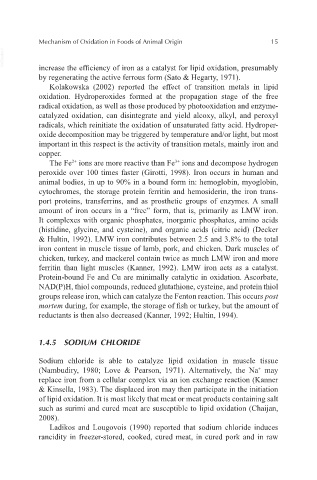Page 36 - Natural Antioxidants, Applications in Foods of Animal Origin
P. 36
Mechanism of Oxidation in Foods of Animal Origin 15
VetBooks.ir increase the efficiency of iron as a catalyst for lipid oxidation, presumably
by regenerating the active ferrous form (Sato & Hegarty, 1971).
Kolakowska (2002) reported the effect of transition metals in lipid
oxidation. Hydroperoxides formed at the propagation stage of the free
radical oxidation, as well as those produced by photooxidation and enzyme-
catalyzed oxidation, can disintegrate and yield alcoxy, alkyl, and peroxyl
radicals, which reinitiate the oxidation of unsaturated fatty acid. Hydroper-
oxide decomposition may be triggered by temperature and/or light, but most
important in this respect is the activity of transition metals, mainly iron and
copper.
The Fe ions are more reactive than Fe ions and decompose hydrogen
3+
2+
peroxide over 100 times faster (Girotti, 1998). Iron occurs in human and
animal bodies, in up to 90% in a bound form in: hemoglobin, myoglobin,
cytochromes, the storage protein ferritin and hemosiderin, the iron trans-
port proteins, transferrins, and as prosthetic groups of enzymes. A small
amount of iron occurs in a “free” form, that is, primarily as LMW iron.
It complexes with organic phosphates, inorganic phosphates, amino acids
(histidine, glycine, and cysteine), and organic acids (citric acid) (Decker
& Hultin, 1992). LMW iron contributes between 2.5 and 3.8% to the total
iron content in muscle tissue of lamb, pork, and chicken. Dark muscles of
chicken, turkey, and mackerel contain twice as much LMW iron and more
ferritin than light muscles (Kanner, 1992). LMW iron acts as a catalyst.
Protein-bound Fe and Cu are minimally catalytic in oxidation. Ascorbate,
NAD(P)H, thiol compounds, reduced glutathione, cysteine, and protein thiol
groups release iron, which can catalyze the Fenton reaction. This occurs post
mortem during, for example, the storage of fish or turkey, but the amount of
reductants is then also decreased (Kanner, 1992; Hultin, 1994).
1.4.5 SODIUM CHLORIDE
Sodium chloride is able to catalyze lipid oxidation in muscle tissue
(Nambudiry, 1980; Love & Pearson, 1971). Alternatively, the Na may
+
replace iron from a cellular complex via an ion exchange reaction (Kanner
& Kinsella, 1983). The displaced iron may then participate in the initiation
of lipid oxidation. It is most likely that meat or meat products containing salt
such as surimi and cured meat are susceptible to lipid oxidation (Chaijan,
2008).
Ladikos and Lougovois (1990) reported that sodium chloride induces
rancidity in freezer-stored, cooked, cured meat, in cured pork and in raw

